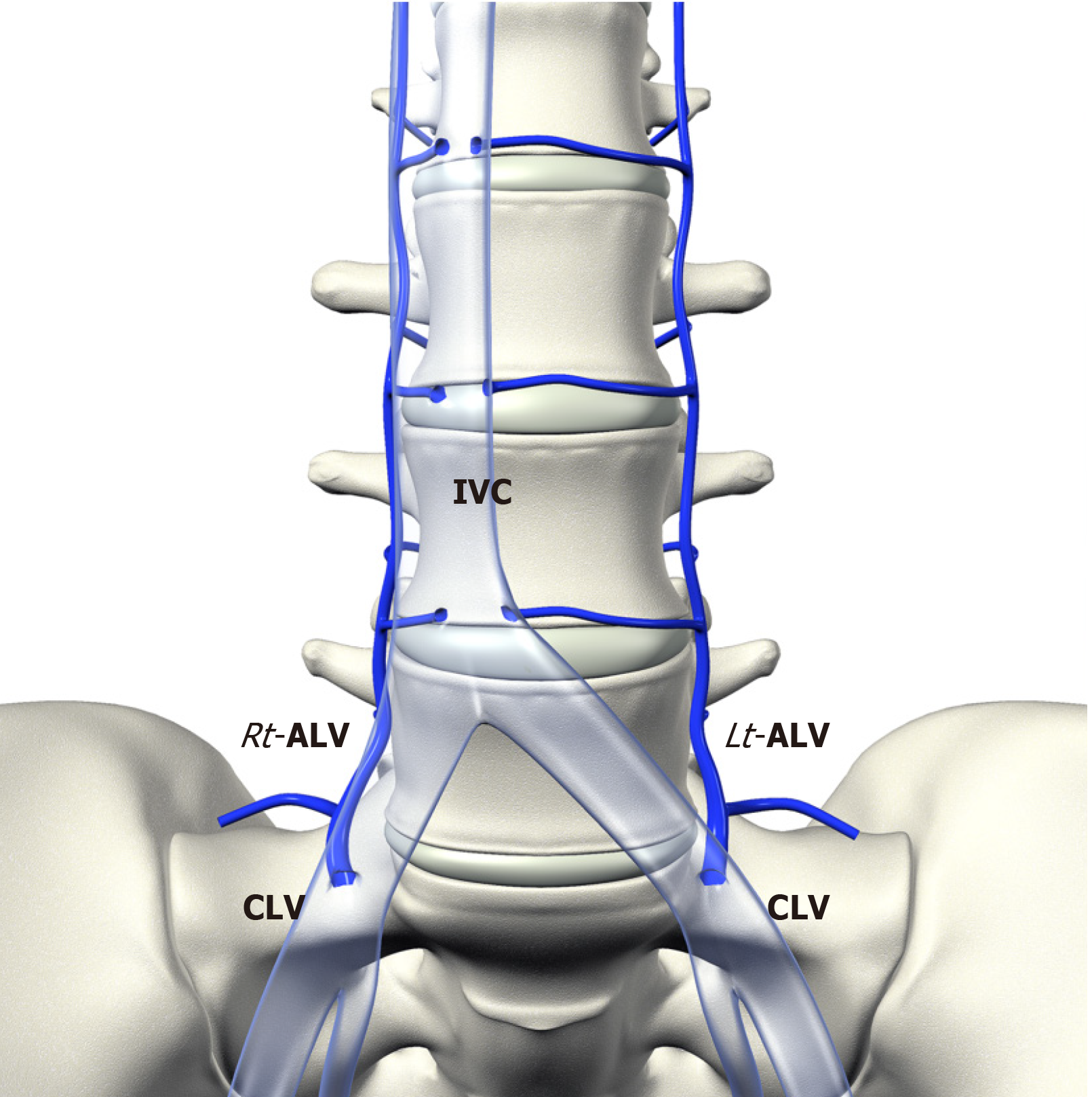Published online Aug 26, 2024. doi: 10.12998/wjcc.v12.i24.5473
Revised: April 29, 2024
Accepted: May 14, 2024
Published online: August 26, 2024
Processing time: 114 Days and 20.7 Hours
The right ascending lumbar vein is difficult to detect on anteroposterior abdo
Core Tip: Intensive observation by medical providers is important to ensure early de
- Citation: Tokumine J, Moriyama K, Yorozu T. Clues for diagnosing misplaced central venous catheter in the right ascending lumbar vein during right femoral venous access. World J Clin Cases 2024; 12(24): 5473-5475
- URL: https://www.wjgnet.com/2307-8960/full/v12/i24/5473.htm
- DOI: https://dx.doi.org/10.12998/wjcc.v12.i24.5473
Zhu et al[1] reported a case in which a central venous catheter was mistakenly placed in the right ascending lumbar vein without symptoms or complications. Since the ascending lumbar vein is small, it can rupture and cause retroperitoneal hemorrhage if an irritant drug is administered through the misplaced catheter. Even without a rupture, catheter mis
It is well-documented that a central venous catheter is misplaced in the left ascending lumbar vein during left femoral venous catheterization[2-7]. In contrast, it is extremely rare for a central venous catheter inserted through the right femoral vein to be misplaced in the right ascending lumbar vein[2,8-10]. The left common iliac vein runs curvature sig
The ascending lumbar vein runs along the lateral aspect of the vertebral body. Therefore, the left ascending lumbar vein is separated from the inferior vena cava and is more likely to be detected on an anteroposterior abdominal X-ray image[2-7]. In contrast, the right ascending lumbar vein is difficult to detect on anteroposterior abdominal radiographs because it overlaps with the inferior vena cava on anteroposterior radiographs[2,8-10]. Zhang et al[2] recommend the use of lateral abdominal X-ray images before computed tomography scan examination for efficacy and economy. However, in the absence of symptoms caused by catheter misplacement, there is no reason to suspect it, negating the need for ad
Intensive observation by medical providers is important in these cases. However, knowledge of catheter misplacement of the right ascending lumbar vein is also necessary, because without that awareness, misplacement cannot be suspected.
| 1. | Zhu XJ, Zhao L, Peng N, Luo JM, Liu SX. Lower extremity peripherally inserted central catheter placement ectopic to the ascending lumbar vein: A case report. World J Clin Cases. 2024;12:1430-1436. [RCA] [PubMed] [DOI] [Full Text] [Full Text (PDF)] [Cited by in RCA: 2] [Reference Citation Analysis (0)] |
| 2. | Zhang X, Chen H, Feng L, Cai Y, Yin W, Hu X, Liu C. Central venous catheters misplaced in paraspinal veins: A systematic literature review based on case reports. Nurs Crit Care. 2021;26:262-273. [RCA] [PubMed] [DOI] [Full Text] [Cited by in Crossref: 2] [Cited by in RCA: 6] [Article Influence: 1.2] [Reference Citation Analysis (0)] |
| 3. | Lavandosky G, Gomez R, Montes J. Potentially lethal misplacement of femoral central venous catheters. Crit Care Med. 1996;24:893-896. [RCA] [PubMed] [DOI] [Full Text] [Cited by in Crossref: 38] [Cited by in RCA: 34] [Article Influence: 1.2] [Reference Citation Analysis (0)] |
| 4. | Carrion E, Hertzog JH, Gunter AW, Lu T, Ruff C, Hauser GJ. Misplacement of a femoral venous catheter into the ascending lumbar vein: repositioning using ultrasonographic guidance. Intensive Care Med. 2001;27:240-242. [RCA] [PubMed] [DOI] [Full Text] [Cited by in Crossref: 14] [Cited by in RCA: 13] [Article Influence: 0.5] [Reference Citation Analysis (0)] |
| 5. | Pichereau C, Ait-Oufella H, Maury E, Guidet B. Unusual misplacement of a femoral central venous catheter. Intensive Care Med. 2011;37:1714-1715. [RCA] [PubMed] [DOI] [Full Text] [Cited by in Crossref: 5] [Cited by in RCA: 10] [Article Influence: 0.7] [Reference Citation Analysis (0)] |
| 6. | Göcze I, Müller-Wille R, Stroszczynski C, Schlitt HJ, Bein T. Accidental cannulation of the left ascending lumbar vein through femoral access-still often unrecognized. ASAIO J. 2012;58:435-437. [RCA] [PubMed] [DOI] [Full Text] [Cited by in Crossref: 8] [Cited by in RCA: 10] [Article Influence: 0.8] [Reference Citation Analysis (0)] |
| 7. | Çelik E, Çora AR. One patient, two malpositioned hemodialysis catheters, (hepatic vein and ascending lumbar vein), no fluoroscopy. Hemodial Int. 2023;27:E12-E14. [RCA] [PubMed] [DOI] [Full Text] [Reference Citation Analysis (0)] |
| 8. | Zenker M, Rupprecht T, Hofbeck M, Schmiedl N, Vetter V, Ries M. Paravertebral and intraspinal malposition of transfemoral central venous catheters in newborns. J Pediatr. 2000;136:837-840. [RCA] [PubMed] [DOI] [Full Text] [Cited by in Crossref: 17] [Cited by in RCA: 17] [Article Influence: 0.7] [Reference Citation Analysis (0)] |
| 9. | Izuishi K, Hashimoto S, Uchinomura S, Usuki H, Masaki T, Maeta H. Malposition of femoral venous cannulation. Am J Surg. 2005;189:47-48. [RCA] [PubMed] [DOI] [Full Text] [Cited by in Crossref: 5] [Cited by in RCA: 7] [Article Influence: 0.4] [Reference Citation Analysis (0)] |
| 10. | Ishihara Y, Fukui H, Fukaguchi K, Sekine I, Yamagami H. Intravascular Catheter Accidentally Placed into the Right Lumbar Vein from the Right Femoral Vein: A Case Report. Am J Case Rep. 2022;23:e936275. [RCA] [PubMed] [DOI] [Full Text] [Full Text (PDF)] [Cited by in RCA: 3] [Reference Citation Analysis (0)] |









